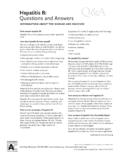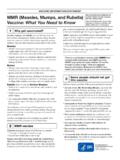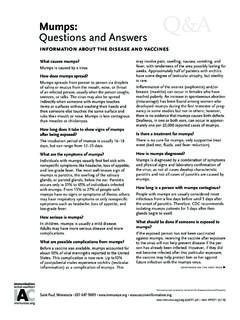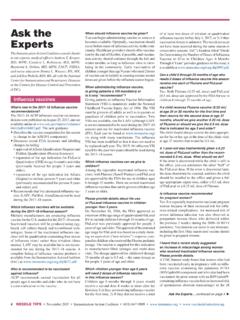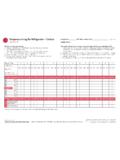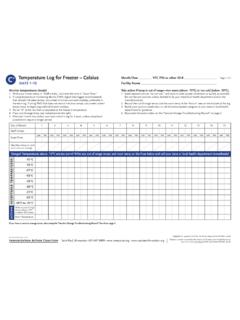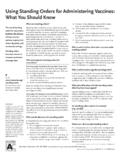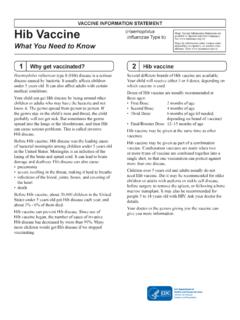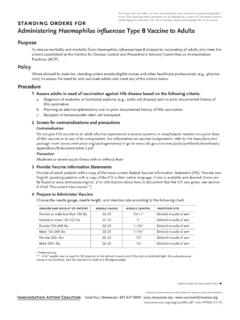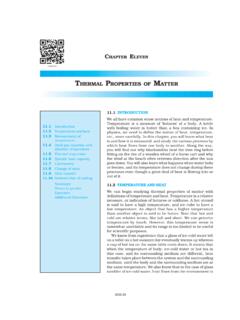Transcription of After the shotswhat to do if your child has discomfort
1 Af ter the child may need extra love and care After getting vaccinated. Some vaccinations that protect children from serious diseases also can cause discomfort for a while. Here are answers to questions many parents have After their children have been vac cinated. If this sheet doesn t answer your questions, call your healthcare provider. Vaccinations may hurt a but disease can hurt a lot!What to do if your child has discomfortI think my child has a fever. What should I do?Check your child s temperature to find out if there is a fever. An easy way to do this is by taking a temperature in the armpit using an electronic ther- mometer (or by using the method of temperature-taking your healthcare provider recommends). If your child has a temperature that your healthcare provider has told you to be concerned about or if you have questions, call your healthcare are some things you can do to help reduce fever: Give your child plenty to drink.
2 Dress your child lightly. Do not cover or wrap your child tightly. Give your child a fever- or pain-reducing medicine such as acetamino-phen ( , Tylenol) or ibuprofen ( , Advil, Motrin). The dose you giveyour child should be based on your child s weight and your healthcareprovider s instructions. See the dose chart on page 2. Do not give your child s temperature After 1 hour. Call your healthcareprovider if you have child has been fussy since getting vaccinated. What should I do? After vaccination, children may be fussy because of pain or fever. To reduce discomfort , you may want to give your child a medicine such as acetami n-ophen or ibuprofen. See the dose chart on page 2. Do not give aspirin. If your child is fussy for more than 24 hours, call your healthcare child s leg or arm is swollen, hot, and red.
3 What should I do? Apply a clean, cool, wet washcloth over the sore area for comfort. For pain, give a medicine such as acetaminophen or ibuprofen. See thedose chart on page 2. Do not give aspirin. If the redness or tenderness increases After 24 hours, call your child seems really sick. Should I call my healthcare provider?If you are worried at all about how your child looks or feels, call your health-care provider! healthcare provider: please fill in the information below. If your child s temperature is F or C or higher, or if you have questions, call your healthcare provider phone numberCall your healthcare provider right away if you answer yes to any of the following questions:Does your child have a temper- ature that your healthcare provider has told you to be concerned about?
4 Is your child pale or limp?Has your child been crying for more than 3 hours and just won t quit? Is your child s body shaking, twitching, or jerking?Is your child very noticeably less active or responsive?Please see page 2 for information on the proper amount of medicine to give your child to reduce pain or fever. Saint Paul, Minnesota 651-6 47-9009 Item #P4015 (2/19) coalitionIless than 11 lbs (5 kg) 0 5 mos12 17 lbs ( kg) 6 11 mos mL Advised dose*18 23 lbs ( kg) 12 23 mos mL Advised dose*24 35 lbs ( kg) 2 3 yrs 5 mL 1 tablet36 47 lbs ( kg) 4 5 yrs mL 11 2 tablets 48 59 lbs ( kg) 6 8 yrs 10 mL 2 tablets60 71 lbs ( kg) 9 10 yrs mL 21 2 tablets72 95 lbs ( kg) 11 yrs 15 mL 3 tabletsChoose the proper medicine, and measure the dose accurately.
5 1. Ask your healthcare provider or pharmacist which medicine is best for your child . 2. Give the dose based on your child s weight. If you don tknow your child s weight, give the dose based on your child s age. Do not give more medicine than is recommended. 3. If you have questions about dosage amounts or any otherconcerns, call your healthcare provider. 4. Always use a proper measuring device when givingacetaminophen liquid ( , Tylenol) or ibuprofen liquid( , Advil, Motrin): Use the device enclosed in the package. If you misplace the device, consult your healthcareprovider or pharmacist for advice. Meal-time spoons are not accurate measures. Neveruse a meal-time spoon for giving these two steps to avoid causing a serious medication overdose in your child .
6 1. Don t give your child a larger amount of acetaminophen( , Tylenol) or ibuprofen ( , Motrin, Advil) than isshown in the table below. Too much of any of these medi-cines can be extremely dangerous. 2. When you give your child acetaminophen or ibuprofen,don t also give them over-the-counter cough or cold medi-cines. This can cause a medication overdose becausecough and cold medicines often contain acetaminophenor ibuprofen. In fact, to be safe, don t ever give over-the-counter cough and cold medicines to your child unlessyou talk to your child s healthcare provider (Tylenol or another brand): How much to give?Give every 4 to 6 hours, as needed, no more than 5 times in 24 hours (unless directed to do otherwise by your healthcare provider).IBUPROFEN (Advil, Motrin, or another brand): How much to give?
7 Give every 6 to 8 hours, as needed, no more than 4 times in 24 hours (unless directed to do otherwise by your healthcare provider).Immunization Action Coalition Item #P4 015 (2/19)* healthcare provider: Please fill in the advised the shots: what to do if your child has discomfort page 2 Medicines and Doses to Reduce Pain and Fever6 11 lbs ( 5 kg) 0 3 mos Advised dose*12 17 lbs ( kg) 4 11 mos mL 18 23 lbs ( kg) 12 23 mos mL24 35 lbs ( kg) 2 3 yrs 5 mL 1 tablet36 47 lbs ( kg) 4 5 yrs mL 11 2 tablets48 59 lbs ( kg) 6 8 yrs 10 mL 2 tablets60 71 lbs ( kg) 9 10 yrs mL 21 2 tablets72 95 lbs ( kg) 11 yrs 15 mL 3 tabletsChild s weightChild s ageInfants or children s liquid160 mg in each 5 mLChildren s chewables current product160 mg in each tabletInfants drops80 mg in each mLChildren s chewables80 mg in each mLThrow away this product.
8 It is out of date and should not be productThrow away this product. It is out of date and should not be productChild s weightChild s ageInfants drops50 mg in mLChildren s liquid100 mg in each 5 mLChildren s chewables or junior tablets100 mg in each tabletChildren s chewables50 mg in each tabletThrow away this product. It is out of date and should not be product
